Trip to the Republic of Guinea – Day Four
Took a pre-breakfast walk down to the mangroves at the mouth of the river. Overcast and windy conditions meant that not many birds were to be seen. Red-chested Swallows were regularly seen overhead, and both Green-backed Heron and Pied Kingfisher were present in the mangroves. All three of the common mangrove trees were in flower, namely Rhizophora mangle, Avicennia germinans and Laguncularia racemosa, giving me a good opportunity to get aquainted with them. 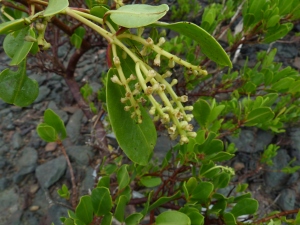 A basic breakfast at the hotel was followed by a drive back up the road to the AluFer camp, where we met up with the Okapi team. The plan was to visit key sites in the project area and get a feel for the issues that need to be dealt with. We started at Kalikali, the northernmost hill in the tenement. The site is characterised by open grassland on laterite, surrounded by closed woodland which is characterised by trees such as Parkia biglobosa, Pterocarpus erinaceus and Lannea species.
A basic breakfast at the hotel was followed by a drive back up the road to the AluFer camp, where we met up with the Okapi team. The plan was to visit key sites in the project area and get a feel for the issues that need to be dealt with. We started at Kalikali, the northernmost hill in the tenement. The site is characterised by open grassland on laterite, surrounded by closed woodland which is characterised by trees such as Parkia biglobosa, Pterocarpus erinaceus and Lannea species. 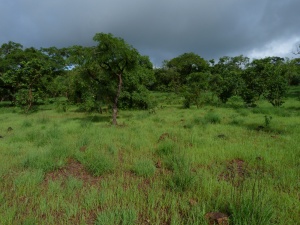 A small non-perennial stream runs through the centre of the grassland and feeds a small patch of gallery forest. From there we moved to another one of the hills in the centre of the project area, and then it was on to Cape Verga at the coast. This rocky promontory is covered with treacherously slippery green algae and we needed to take care walking across the rocks. A small grove of Rhizophora mangrove trees has established on the rocks, and another mangrove species, Conocarpus erectus, was found.
A small non-perennial stream runs through the centre of the grassland and feeds a small patch of gallery forest. From there we moved to another one of the hills in the centre of the project area, and then it was on to Cape Verga at the coast. This rocky promontory is covered with treacherously slippery green algae and we needed to take care walking across the rocks. A small grove of Rhizophora mangrove trees has established on the rocks, and another mangrove species, Conocarpus erectus, was found.  We then drove back to the AluFer camp for a late lunch, after which we decided to try and find one of the sacred forests in order to get an idea of the biodiversity value of these relic forests.
We then drove back to the AluFer camp for a late lunch, after which we decided to try and find one of the sacred forests in order to get an idea of the biodiversity value of these relic forests.
We drove to Damouya Sacred Forest, hoping to just get to see the edge of the forest but realising that the chance of being able to enter the forest was unlikely. Imagine our suprise when some of the local community members who were planting rice at the edge of the forest offered to take us in to the forest and show us a cave site! Ecstatic we quickly agreed and followed two of them into the tall forest. A short walk down to the forested stream revealed a small waterfall over a rock ledge and under the ledge was a deep overhang which could ostensibly be called a cave. 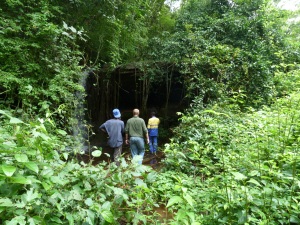 I was hoping to find evidence of nesting Picathartes, a rare and secretive bizarre bird that nests in forested caves, but was unsuccessful. However, the locals said that birds do use this cave, so it could still be possible! We were not allowed much time in the forest and had to leave after a few minutes at the cave. Even that short time was worth it and I was overjoyed – definitely a highlight of this trip. That was it for the day and we headed back to camp.
I was hoping to find evidence of nesting Picathartes, a rare and secretive bizarre bird that nests in forested caves, but was unsuccessful. However, the locals said that birds do use this cave, so it could still be possible! We were not allowed much time in the forest and had to leave after a few minutes at the cave. Even that short time was worth it and I was overjoyed – definitely a highlight of this trip. That was it for the day and we headed back to camp.
Trip to the Republic of Guinea – Day Three
We were back at the airport after an early breakfast this morning. Check-in went smoothly and it wasn’t long before we sitting in the departure lounge once again, hoping for a different result today. And that is what we got. The plane departed according to schedule and in an hour and a half we touched down in a rainy Conakry. Until now everything had run quite smoothly….remember my comment yesterday??? Not understanding French is a huge disadvantage, but we could see that more and more people were getting disgruntled at the news coming through at the baggage collection point. The AluFer staff member that had come to meet us soon informed us that our luggage had not arrived! Senegal Airlines had forgot to load everyone’s luggage. Seems they suffer from an advanced form of incompetence! We had no choice but to head out to our vehicle and drive north to the project area. Another day in the same set of clothing awaited us!
Conakry is situated on a long peninsula which is covered by urban sprawl. Traffic congestion is rife and it was easy to see how the 270 km drive to site could sometimes take up to 6 hours. 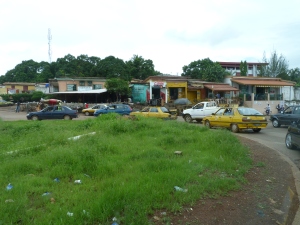 Once we had wrestled ourselves free of Conakry we could pick up speed. We followed the highway along the coastal plain, with beautiful views of the escarpment to the east. It was clear that we were well into the wet season, with many waterfalls flowing off the sheer escarpment cliffs and most rivers in spate. Very few areas of natural habitat remain, with even the upper slopes of the steep escarpment suffering deforestation.
Once we had wrestled ourselves free of Conakry we could pick up speed. We followed the highway along the coastal plain, with beautiful views of the escarpment to the east. It was clear that we were well into the wet season, with many waterfalls flowing off the sheer escarpment cliffs and most rivers in spate. Very few areas of natural habitat remain, with even the upper slopes of the steep escarpment suffering deforestation. 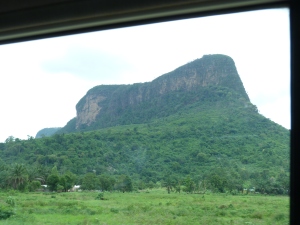 We arrived at the small town of Boffa at midday where we met with the district commissioner and two of his assistants, as well as the Okapi Environmental team. After a short meeting and introductions we continued along the coast towards Bel-Air, with two stops within the project area to orientate us. We stopped for a brief afternoon meal at the AluFer camp, after which we continued to the Bel-Air Hotel.
We arrived at the small town of Boffa at midday where we met with the district commissioner and two of his assistants, as well as the Okapi Environmental team. After a short meeting and introductions we continued along the coast towards Bel-Air, with two stops within the project area to orientate us. We stopped for a brief afternoon meal at the AluFer camp, after which we continued to the Bel-Air Hotel.
Trip to the Republic of Guinea – Day Two
The morning was spent at the Terrou-Bi Hotel, situated on a small private beach along the Senegal coastline and overlooking the Iles des Madeleines. 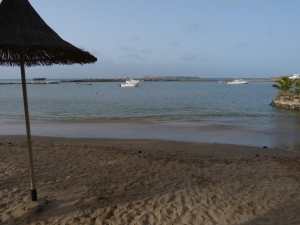 A morning walk along the coastline did not produce much apart from a few White-breasted Cormorants perched on boats in the small harbour, a pair of Spur-winged Lapwings in the hotel grounds, several Common Bulbuls in the garden and two Western Reef Herons along the rocks.
A morning walk along the coastline did not produce much apart from a few White-breasted Cormorants perched on boats in the small harbour, a pair of Spur-winged Lapwings in the hotel grounds, several Common Bulbuls in the garden and two Western Reef Herons along the rocks.  The team met each other properly after breakfast and then we had time to do a bit of work until checkout time. From there it was back to the airport for an evening flight to Conakry (Republic of Guinea). When travelling in West Africa its good to keep in mind that when it seems to be going so smoothly, then something is about to go wrong! We had checked through to the departure lounge and were waiting for our flight when we were told that the weather in Conakry was too bad for us to land. The flight was being postponed to tomorrow morning 10h00!! So we had to get a taxi back to the Terrou-Bi for another night at the hotel. Worse still, our luggage had already been loaded onto the plane, so were without our luggage.
The team met each other properly after breakfast and then we had time to do a bit of work until checkout time. From there it was back to the airport for an evening flight to Conakry (Republic of Guinea). When travelling in West Africa its good to keep in mind that when it seems to be going so smoothly, then something is about to go wrong! We had checked through to the departure lounge and were waiting for our flight when we were told that the weather in Conakry was too bad for us to land. The flight was being postponed to tomorrow morning 10h00!! So we had to get a taxi back to the Terrou-Bi for another night at the hotel. Worse still, our luggage had already been loaded onto the plane, so were without our luggage.
Trip to the Republic of Guinea – Day One
Met up with Fanie Coetzee of Epoch Resources at O.R.Tambo International Airport and headed through to the departure lounge for a coffee. The purpose of this trip is to see the AluFer bauxite mine project at Bel-Air in coastal Guinea and then to review the reports produced to date in the context of what we have seen. The route to Guinea was not a simple one and involved quite a bit of travel. Our plane to Dakar departed at 19h00 as scheduled and I had my first look at the specialist reports that had been compiled late last year in the project area. Even though the flight took 8.5 hours, the change in time zones meant we landed at 01h30 in Dakar, Senegal. Amazingly, even at that crazy time there was still a fair amount of traffic on the road between the airport and our hotel. We checked into the hotel Terrou-Bi at about 02h30 and stumbled to our rooms.